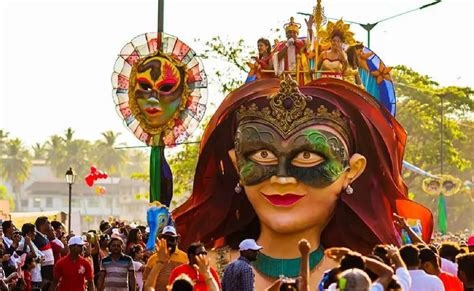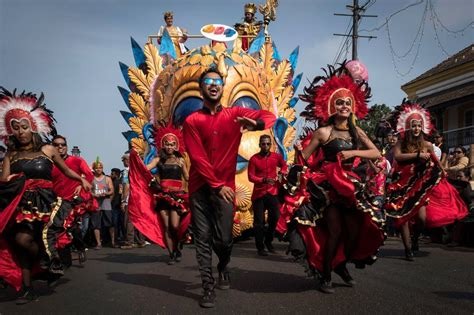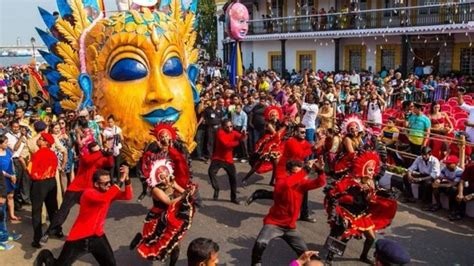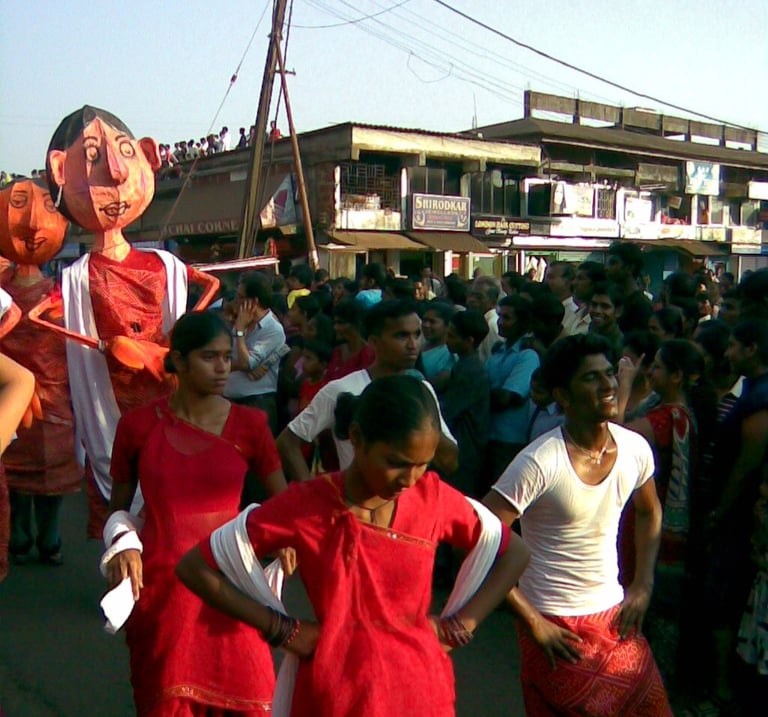Goa Carnival – A Cultural Extravaganza Beyond the Classroom
Experience the magic of Goa Carnival beyond textbooks! Dive into a world of music, dance, and tradition, uncovering the rich cultural tapestry that makes this festival unforgettable. Read more on EduBeatsWorld!
edubeatsworld.com
Introduction
The ‘Goa Carnival’ is one of the most vibrant and exhilarating festivals in India, drawing tourists from around the world. Known for its grand parades, lively music, and colorful floats, the festival is deeply rooted in Portuguese traditions. Celebrated before the Christian season of Lent, this carnival has become a significant cultural event, merging history, music, art, and tourism. But beyond the revelry, the Goa Carnival provides valuable lessons that extend beyond traditional classrooms. This post explores how the carnival serves as a rich learning experience, incorporating history, music, cultural diversity, economy, and social awareness.


Acknowledgments: We thank all contributors for the images on Goa Carnival featured on this site.
1. The History and Significance of Goa Carnival
The ‘Goa Carnival’ dates back to the 18th century when Portuguese colonial rulers introduced the festival as a pre-Lenten celebration. The festival was meant as a time for feasting and merrymaking before the solemn observances of Lent, during which Christians traditionally fasted and abstained from certain indulgences. Over time, this European tradition blended with Goan cultural elements, creating a unique festival that continues to thrive today.
Historical Evolution
- Portuguese Influence: Goa, a Portuguese colony until 1961, inherited many Western customs and celebrations, including the carnival. Initially reserved for the elite, it later gained widespread popularity among locals.
- Local Adaptations: With Goa’s rich Hindu and Konkani traditions, the carnival incorporated elements from local folklore, adding a distinct Indian flavor to its celebrations.
- Modern-Day Carnival: Today, the Goa Carnival is an international event, attracting thousands of visitors and significantly contributing to the state’s economy.
Interesting Statistics
- Tourism Impact: In 2023, the Goa Carnival attracted over 100,000 tourists, contributing significantly to Goa’s ₹3,500 crore tourism industry.
- Economic Boost: The hospitality sector experiences a 20% spike in revenue, with hotels, restaurants, and transport services seeing higher demand.
- Cultural Preservation: The festival is now a UNESCO-listed intangible cultural heritage, highlighting its importance in global traditions.
The Global Perspective
The Goa Carnival has not only become a local celebration but has also attracted international attention. Many visitors plan their travels around this festival, showcasing the global interest in cultural experiences. The carnival serves as a reminder of the importance of preserving local traditions in an increasingly globalized world. Additionally, the carnival seeks to maintain its relevance by integrating contemporary issues.
Engaging Local Communities
The festival encourages local communities to participate actively, not only as audiences but as key players in the carnival’s organization. This fosters a sense of ownership and pride in their cultural heritage, promoting engagement in preserving centuries-old traditions.
2. Music and Dance – The Heart of the Carnival
The pulsating energy of the Goa Carnival is incomplete without its music and dance, making it an excellent case study for students of music and performing arts. The carnival showcases diverse genres, from Portuguese Fado music to contemporary Bollywood beats.


Musical Elements in the Carnival
- Konkani Folk Music: Traditional Goan songs, performed with instruments like the ghumot (a clay drum) and the violin.
- Western Influence: Bands play Portuguese-inspired Fado music and Latin American salsa.
- Modern Fusion: DJs and local artists create a mix of electronic beats and Goan melodies, showcasing a unique blend of traditions.
Popular Dance Forms
- Corridinho: A Portuguese folk dance performed in colorful costumes, often involving intricate footwork and lively rhythms.
- Samba & Salsa: Influenced by Latin American culture, these dance forms add international flair and engage the audience, encouraging participation.
- Bollywood Fusion: Contemporary Bollywood songs dominate the street performances, ensuring high energy levels and widespread appeal.
King Momo’s Influence
The carnival begins with the arrival of ‘King Momo’, the mythical figure who officially declares the celebrations open. His proclamation, ‘Khaya, piya ani mouza kora.’ (Eat, drink, and make merry), symbolizes the festival’s spirit, embodying joy and festivity. The tradition of ‘King Momo’ serves as a perfect lesson in leadership, folklore, and historical storytelling.
Workshops and Learning Opportunities
Many local schools and cultural organizations offer workshops during the carnival, teaching music and dance forms associated with the festival. This hands-on experience allows participants to connect with their cultural heritage, learn about preservation, and appreciate the different styles of music and dance that are part of Goa's identity.


3. The Artistic and Cultural Impact
One of the most visually stunning aspects of the Goa Carnival is the artistic expression through floats, masks, and costumes. This provides a deep insight into artistic heritage, creativity, and storytelling.
Float Making – A Lesson in Art and Creativity
Each year, different communities and artists design massive floats, competing for the best visual representation. These floats often depict:
- Social issues such as ‘environmental conservation and gender equality’.
- Traditional Goan themes like ‘fishermen’s lives and Konkani folklore’.
- Satirical political messages, offering a ‘lesson in freedom of expression’ and the role of art in society.
Traditional Carnival Costumes
- Masquerade Masks, Feathered Hats, and Vibrant Dresses: Inspired by European carnivals, these costumes are an artistic reflection of Goa's cultural identity.
- Local Handicrafts: Many costumes feature Goan beadwork and embroidery, supporting local artisans.
- Sustainability Awareness: A growing trend in recent years has been the use of ‘eco-friendly materials’ for floats and costumes, reinforcing the carnival's commitment to responsible celebrations.
Community Art Projects
Local artists often collaborate on community projects leading up to the carnival, allowing residents to engage in creating art that reflects their culture and values. These initiatives not only beautify the community but also foster a sense of unity and pride while educating participants about artistic techniques and historical references.
4. Tourism, Economy, and Social Learning
The Goa Carnival is more than just entertainment – it is an economic powerhouse that teaches valuable lessons in tourism, business, and community development.
Economic Contributions
- Boost to Hospitality: Goa sees a 30% increase in hotel bookings during carnival season, benefitting local businesses.
- Local Business Growth: Street vendors, artisans, and performers earn substantial income from the influx of visitors. This creates a significant temporary boost to the local economy.
- Employment Opportunities: The event generates seasonal jobs in ‘event management, security, and hospitality’, as well as opportunities for local artisans to showcase and sell their crafts.
Social and Cultural Learning
- The carnival promotes ‘intercultural understanding’, as people from different nationalities and backgrounds come together.
- It emphasizes ‘teamwork and coordination’, as large groups work together to organize parades, creating a cooperative spirit among participants.
- Encourages ‘social responsibility’ through themes highlighting issues like gender equality, sustainability, and tourism ethics.
Example: Community Involvement
- Schools and colleges participate in float-making contests, allowing students to understand ‘project management and teamwork’. This inclusive approach nurtures creativity and instills a sense of pride in cultural heritage.
- NGOs use the carnival as a platform to spread awareness on ‘mental health, child welfare, and other social issues’, integrating performances that highlight these themes.
The Future of Carnival Tourism
The Goa Carnival exemplifies sustainable tourism, where cultural preservation meets economic success. As interest in local experiences grows, tourism stakeholders are increasingly focused on creating initiatives that are both economically and environmentally sustainable.


5. Lessons Beyond the Classroom
Goa Carnival provides invaluable ‘real-world learning experiences’ that are difficult to replicate in textbooks. Here are some key takeaways:
1. History and Heritage
- Understanding the ‘Portuguese influence on Indian traditions’ and how this shapes modern identities.
- The role of ‘festivals in shaping national and regional identity’, serving as a unifying event for diverse communities.
2. Music and Performing Arts
- Exploring the fusion of ‘Goan, Portuguese, and modern music styles’, emphasizing the evolution of cultural expression.
- Learning about ‘stage performance techniques and audience engagement strategies’.
3. Business and Economics
- Understanding ‘tourism-driven economies’ and the intricacies of seasonal business fluctuations.
- Observing the role of ‘festivals in job creation and business growth’, particularly within the local community.
4. Art, Design, and Innovation
- Creativity in float-making and costume design offers insight into artistic processes and collaborative efforts.
- Discussion on the importance of using eco-friendly materials in large-scale events, promoting environmental consciousness.
5. Social Awareness and Communication
- How carnivals act as a platform for social messages, challenging societal norms and promoting conversation.
- The importance of community involvement in cultural preservation and education, demonstrating active citizenship.
Conclusion
Goa Carnival is not just a celebration; it is a ‘classroom without walls’, offering lessons in history, music, art, business, and society. Whether through its rhythmic beats, dazzling costumes, or economic significance, this festival teaches ‘valuable life skills and cross-cultural understanding’. For students and educators alike, witnessing or studying the Goa Carnival is an enriching experience that truly extends ‘beyond the classroom’.
So, are you ready to immerse yourself in this colorful tapestry of culture and celebration? Plan a visit to experience the magic of the Goa Carnival firsthand—a learning adventure you'll treasure forever!
contact@edubeatsworld.com
© 2024. All rights reserved.
